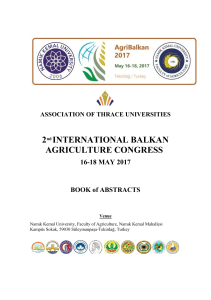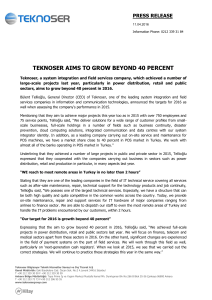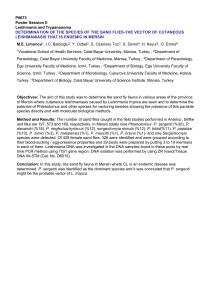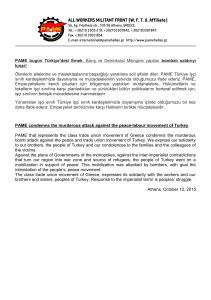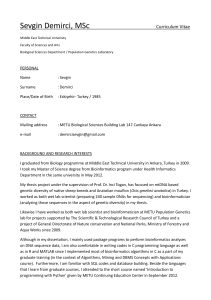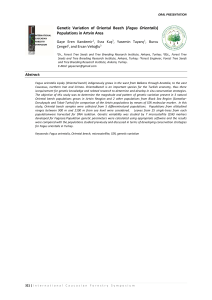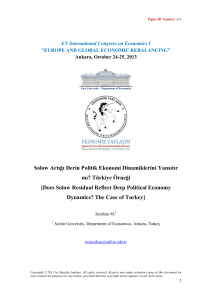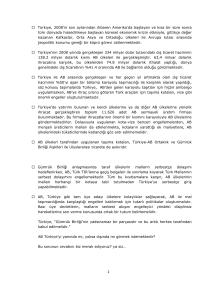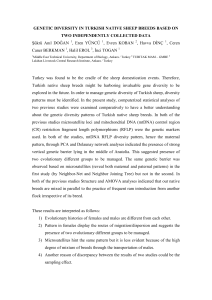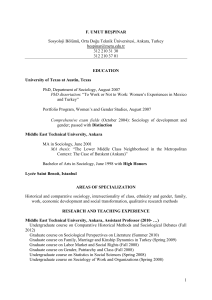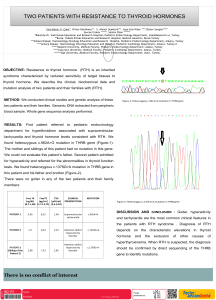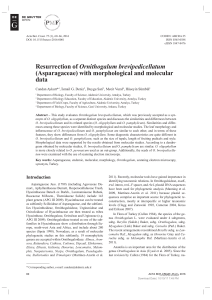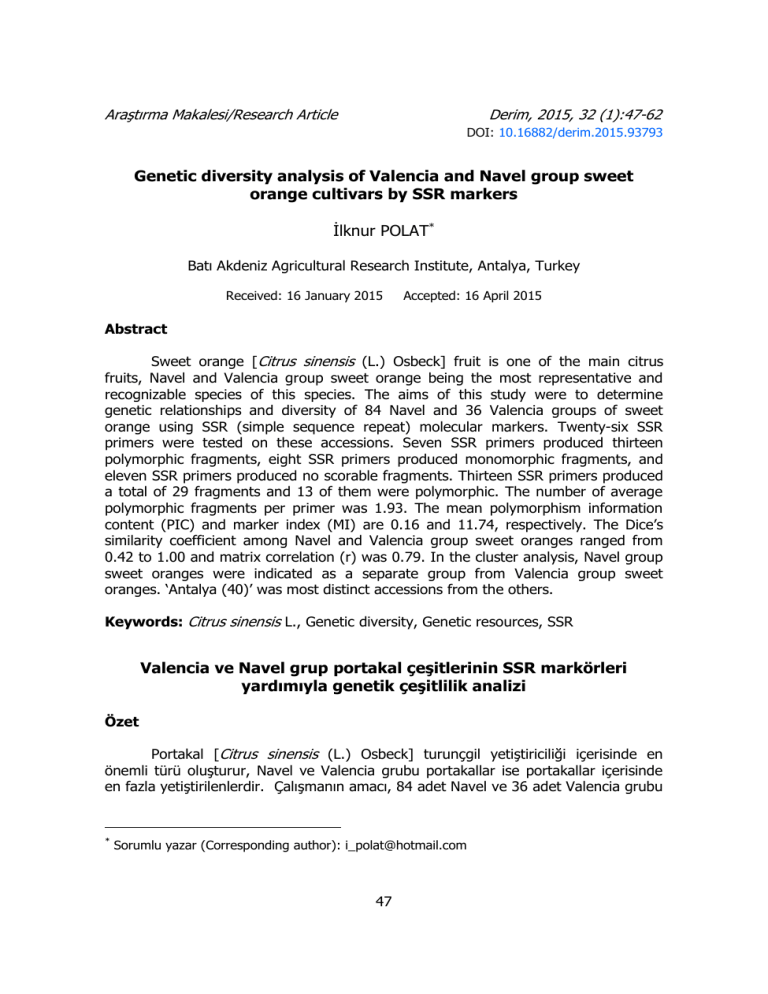
Araştırma Makalesi/Research Article
Derim, 2015, 32 (1):47-62
DOI: 10.16882/derim.2015.93793
Genetic diversity analysis of Valencia and Navel group sweet
orange cultivars by SSR markers
İlknur POLAT*
Batı Akdeniz Agricultural Research Institute, Antalya, Turkey
Received: 16 January 2015
Accepted: 16 April 2015
Abstract
Sweet orange [Citrus sinensis (L.) Osbeck] fruit is one of the main citrus
fruits, Navel and Valencia group sweet orange being the most representative and
recognizable species of this species. The aims of this study were to determine
genetic relationships and diversity of 84 Navel and 36 Valencia groups of sweet
orange using SSR (simple sequence repeat) molecular markers. Twenty-six SSR
primers were tested on these accessions. Seven SSR primers produced thirteen
polymorphic fragments, eight SSR primers produced monomorphic fragments, and
eleven SSR primers produced no scorable fragments. Thirteen SSR primers produced
a total of 29 fragments and 13 of them were polymorphic. The number of average
polymorphic fragments per primer was 1.93. The mean polymorphism information
content (PIC) and marker index (MI) are 0.16 and 11.74, respectively. The Dice’s
similarity coefficient among Navel and Valencia group sweet oranges ranged from
0.42 to 1.00 and matrix correlation (r) was 0.79. In the cluster analysis, Navel group
sweet oranges were indicated as a separate group from Valencia group sweet
oranges. ‘Antalya (40)’ was most distinct accessions from the others.
Keywords: Citrus sinensis L., Genetic diversity, Genetic resources, SSR
Valencia ve Navel grup portakal çeşitlerinin SSR markörleri
yardımıyla genetik çeşitlilik analizi
Özet
Portakal [Citrus sinensis (L.) Osbeck] turunçgil yetiştiriciliği içerisinde en
önemli türü oluşturur, Navel ve Valencia grubu portakallar ise portakallar içerisinde
en fazla yetiştirilenlerdir. Çalışmanın amacı, 84 adet Navel ve 36 adet Valencia grubu
*
Sorumlu yazar (Corresponding author): [email protected]
47
Derim, 2015, 32 (1):47-62
portakalın SSR (simple sequence repeat) moleküler markırı kullanarak genetik
akrabalıklarını ve farklılıklarını belirlemektir. Kullanılan 26 SSR primerinden 13 tanesi
polimorfik, 8 tanesi monomorfik bant sağlarken, 11 primerden değerlendirilebilecek
bant elde edilememiştir. Polimorfizm sağlayan 13 SSR primerinden toplam 29 bant
elde edilmiş ve bunların 13 adeti polimorfizm sağlamıştır. Her bir primere düşen
ortalama polimorfik bant sayısı 1.93’tür. Ortalama PIC (polymorphism information
content) ve MI (marker index) değerleri sırasıyla 0.16 ve 11.74’dür. Navel ve Valencia
grubu portakallarında Dice’ın benzerlik indisi (Dice’s similarity coefficient) 0.42 ile
1.00 arasında değişim göstermiştir, matriks korelasyon (r=matrix correlation) ise
0.79’dur. Kümeleme analizinde (cluster analysis) ise, Navel grubu portakallar Valencia
grubu portakallardan ayrılmıştır. ‘Antalya (40)’ tüm portakal grupları içerisinde en
uzak bireyi oluşturmuştur.
Anahtar kelimeler: Citrus sinensis L., Genetik farklılık, Genetik kaynak, SSR
1. Introduction
Sweet orange is an economically important citrus crop in Turkey and
worldwide. Total sweet orange production in Turkey is approximately
1 781 258 tons and 1 333 254 tons of this was Washington Navel, 72 419
tons was Yafa, 375 585 tons of this was the other sweet oranges such as
Valencia (TUIK, 2013).
The sweet orange originated from Asia and its hybrid characteristic
seems to come from a cross between mandarin ( Citrus reticulata Blanco)
and pummelo [Citrus grandis (L.) Osbeck] (Davies and Albrigo, 1994;
Nicolosi et al., 2000). Citrus varieties show diversity in their morphological,
chemical constituents and for convenience. Sweet oranges are classified into
four groups: Common (round oranges), low acidity, pigmented (blood) and
navel oranges (Hodgson, 1967; Davies and Albrigo, 1994).The round
oranges are most important commercially and represent a major portion of
sweet oranges. Valencia oranges are included in the round oranges. Navel
oranges are the second most widely planted group while blood orange
plantings are limited primarily to areas with Mediterranean-type climates
(Davies and Albrigo, 1994).
Study of Citrus taxonomy and phylogeny is complicated and quite
difficult due to wide cross-compatibility among the species, apomixis,
nucellar embryony, high frequency of bud mutation, the long history of
cultivation, a long juvenile phase and the paucity of remaining wild citrus
stands (Nicolosi et al.,2000).
48
Derim, 2015, 32 (1):47-62
In the past, systems of citrus genetic classification were based upon
mainly morphological characteristics (Nicolosi et al., 2000; Barkley et al.,
2006). A number of molecular marker techniques have been used to
overcome the limitations of morphological and biochemical markers in citrus
genetic classification. Protein, isozymes (Rahman and Nito, 1994), and
molecular markers such as restriction fragment length polymorphisms
(RFLPs) (Liou et al., 1996), random amplified polymorphic DNA (RAPD)
(Machado et al.,1996; Baig et al., 2009; Sun et al.,2012; Malik et al.,2012),
sequence-characterized amplified regions (SCARs) (Nicolosi et al., 2000),
amplified fragment length polymorphism (AFLP) (Campos et al., 2005),
microsatellites simple sequence repeats (SSRs) (Oliveira et al., 2002; Ahmad
et al., 2003; Fu et al., 2003; Barkley et al., 2006; Polat, 2009; Jannati et al.,
2009; El-Mouei et al., 2011; Uzun et al., 2011; Cristofani-Yaly et al., 2011;
Garcίa-Lor et al., 2012; Polat et al., 2012; Kacar et al., 2013; Al-Mouei and
Choumane, 2014), inter-simple sequence repeats (ISSRs) (De Pasquale et
al., 2006), sequence related amplified polymorphism (SRAP) (Uzun et al.,
2009; Uzun et al., 2011; Polat et al., 2012; Kacar et al., 2013), sequencespecific amplified polymorphism (S-SAP) and selectively amplified
microsatellite polymorphic loci (SAMPL) (Biswas et al., 2011) have been
employed to elucidating genetic diversity, determining parentage, and
revealing phylogenetic relationships among various Citrus species. Compared
to morphological data, molecular markers provide abundant information, are
highly efficient, and are insensitive to environmental factors (Barkley et al.,
2006).
Each molecular marker technique is based on different principles but
their application is to bring out the genome-wide variability (Biswas et al.,
2011). In general, the choice of molecular marker technique has to be a
compromise between reliability and ease of analysis, statistical power and
confidence of revealing polymorphisms (Agarwal et al., 2008). SSR markers
are codominant, highly polymorphic, easy to use (Barkley et al., 2009) and
is, therefore, ideal in the analysis of large genomes (Barkley et al., 2009;
Biswas et al., 2011; Amar et al., 2011). In our study, genetic relationships
and diversity were determined using SSR molecular marker within 84 Navel
and 36 Valencia groups of sweet oranges collected from selections and
introductions.
49
Derim, 2015, 32 (1):47-62
2. Material and Methods
2.1. Plant material
Eighty-four Navel and thirty-six Valencia group genotypes of sweet
orange [Citrus sinensis (L.) Osbeck] were used. DNA samples of all plant
materials from the Tuzcu Citrus Collection (University of Cukurova, Adana,
Turkey), Bati Akdeniz Agricultural Research Institute Citrus Collection
(Antalya, Turkey) and Alata Horticultural Research Station Citrus Collection
(Mersin, Turkey) were obtained from Alata Horticultural Research Station
under the project that supported by the Scientific and Technological
Research Council of Turkey (TUBITAK) (Table 1).
2.2. SSR analysis
Twenty-six primer pairs (Barkley et al., 2006; Roose, 2009) were used
to amplify the DNA. Fifteen primer pairs producing scorable polymorphic
bands were used to amplify all of the accessions (Table 2). PCR
amplifications were conducted as described by Barkley et al., (2006) with
some modifications. Each 10 μl reaction consisted of 1.0 μl primers, 200 mM
of each deoxyribonucleotide triphosphate (dNTP), 1.0 μl 10X PCR buffer, 1.0
μl 2.5 mM MgCl2 4.8 μl double-distilled water, 0.2 μl 0.6 U Taq DNA
polymerase and 1.0 μl 20 ng DNA. A DNA Thermal Cycler (Bio-Rad,
Hercules, CA, USA) was used, and the cycling parameters included 3 min of
initial denaturing at 94°C, 35 cycles of 3 steps [30 sec of denaturing at
94°C, 30 sec of annealing at 50°C or 45°C (depending on the primer), and 1
min of elongation at 72°C], and 1 cycle of 10 min at 72°C for extension. PCR
products good amplified at annealing temperature of 45°C in TAA52, TAA15
and CAGG9 primers, 50°C in the others primers (Table 2).
PCR products were separated on 2.5% high resolution agarose
(Ambresco, Solon, OH USA) gel in 1X TAE buffer at 100 V for 3 h, and
photographed (used Kodak Gel Logic 200) under UV light for further
analysis. A 100 bp DNA ladder (Vivantis, Oceanside, CA, USA) was used as
molecular standard.
50
1
2
3
4
5
6
7
8
9
10
11
12
13
14
15
16
17
18
19
20
21
22
23
24
25
26
27
28
29
30
No
Group
Name
Navel
Navel
Navel
Navel
Navel
Navel
Navel
Navel
Navel
Navel
Navel
Navel
Navel
Navel
Navel
Navel
Navel
Navel
Navel
Navel
Navel
Navel
Navel
Navel
Navel
Navel
Navel
Navel
Navel
Navel
USA
USA
Nucellar
Nucellar
Nucellar
Nucellar
Nucellar
Nucellar
Nucellar
Nucellar
Turkey
Turkey
TRNC
TRNC
TRNC
Turkey
USA
USA
USA
Turkey
Turkey
France
France
Unknown
Unknown
Spain
Spain
Spain
Spain
Spain
Origin
Tulegold
Thomson Navel (7365 T)
Washington Navel (A-6) (Antalya (6)
Washington Navel (A-4) (Antalya (4)
Washington Navel Antalya (1)
Tuzcu - 2 N
Washington Navel Antalya (8)
Washington Navel Antalya (2)
Washington Navel Antalya (10)
Washington Navel Antalya (3)
Washington Navel Antalya (40)
Washington Navel Antalya (39)
Washington Navel (Kıbrıs 1)
Washington Navel (Kıbrıs 2)
Washington Navel (Kıbrıs 3)
Washington Navel (Adana)
Skaggs Bonanza Navel
Frost Washington Navel (6615 T)
Newhall Navel (7922 T)
Washington Navel Antalya (7)
Washington Navel Antalya (37)
Navelate SRA 307
Navelate SRA 305
Cara Cara
Spring Navel
Navelina IVIA 7-5
Navelate IVIA 2-7
Morita Navel IVIA
Apopka Navel IVIA 201 - 01
Leng Navel IVIA 216 - 01
Cultivar Name
61
62
63
64
65
66
67
68
69
70
71
72
73
74
75
76
77
78
79
80
81
82
83
84
85
86
87
88
89
90
No
Group
Name
Navel
Navel
Navel
Navel
Navel
Navel
Navel
Navel
Navel
Navel
Navel
Navel
Navel
Navel
Navel
Navel
Navel
Navel
Navel
Navel
Navel
Navel
Navel
Navel
Valencia
Valencia
Valencia
Valencia
Valencia
Valencia
Turkey
Turkey
Turkey
Turkey
Turkey
Turkey
Turkey
Turkey
Turkey
Turkey
Turkey
Turkey
Turkey
Turkey
Turkey
Turkey
Turkey
Turkey
Turkey
Turkey
Turkey
Turkey
Turkey
Turkey
USA
USA
USA
France
Unknown
TRNC
Origin
Washington Navel (Navel 28-M)
Washington Navel (Navel 29-M)
Washington Navel (Navel 3-M)
Washington Navel (Navel 30-M)
Washington Navel (Navel 31-M)
Washington Navel (Navel 32-M)
Washington Navel (Navel 33-M)
Washington Navel (Navel 34-M)
Washington Navel (Navel 35-M)
Washington Navel (Navel 36-M)
Washington Navel (Navel 37-M)
Washington Navel (Navel 38-M)
Washington Navel (Navel 39-M)
Washington Navel (Navel 4-M)
Washington Navel (Navel 40-M)
Washington Navel (Navel 41-M)
Washington Navel (Navel 42-M)
Washington Navel (Navel 5-M)
Washington Navel (Navel 6-M)
Washington Navel (Navel 7-M)
Washington Navel (Navel 8-M)
Washington Navel (Navel 85-M)
Washington Navel (Navel 86-M)
Washington Navel (Navel 9-M)
Campbell Valencia (7246 R, N)
Frost Valencia (7246 R, N)
Olinda Valencia (7229 R)
Rhode Red Valencia SRA 360
Midknight Valencia
KKTC-19 Valencia
Cultivar Name
Table 1. Plant materials used in this study were identified by Tanaka species name, common or cultivar names and
origin or country names
Derim, 2015, 32 (1):47-62
51
Navel
Navel
Navel
Navel
Navel
Navel
Navel
Navel
Navel
Navel
Navel
Navel
Navel
Navel
Navel
Navel
Navel
Navel
Navel
Navel
Navel
Navel
Navel
Navel
Navel
Navel
Navel
Navel
Navel
Navel
31
32
33
34
35
36
37
38
39
40
41
42
43
44
45
46
47
48
49
50
51
52
53
54
55
56
57
58
59
60
52
Turkey
Turkey
Turkey
Turkey
Turkey
Turkey
Turkey
Turkey
Turkey
Turkey
Turkey
Spain
Spain
Spain
Spain
Spain
France
USA
Unknown
TRNC
TRNC
Unknown
Italy
Turkey
Nucellar
Turkey
Turkey
Turkey
Turkey
Turkey
Table 1. (Continued)
Dream Navel IVIA 213 - 01
Fisher Navel IVIA 199 - 01
Cram Navel IVIA 211- 01
N. Lane Late IVIA 198 - 1
Navelate IVIA 72 - 12
Robertson SRA 209 portakalı
Navalate 548
Fukumoto
KKTC-13 Washington Navel
KKTC-10 Washington Navel
Gillette
Goldnugget-B
Navelli Kan 3-11
Washington Navel (Antalya-9)
Washington Navel (Navel 10-M)
Washington Navel (Navel 11-M)
Washington Navel (Navel 12-M)
Washington Navel (Navel 14-M)
Gazipaşa Göçek Köyü Göbekli
Portakalı
Washington Navel (Navel 1-M)
Washington Navel (Navel 15-M)
Washington Navel (Navel 17-M)
Washington Navel (Navel 18-M)
Washington Navel (Navel 2-M)
Washington Navel (Navel 20-M)
Washington Navel (Navel 21-M)
Washington Navel (Navel 23-M)
Washington Navel (Navel 24-M)
Washington Navel (Navel 25-M)
Washington Navel (Navel 27-M)
110
111
112
113
114
115
116
117
118
119
120
91
92
93
94
95
96
97
98
99
100
101
102
103
104
105
106
107
108
109
Valencia
Valencia
Valencia
Valencia
Valencia
Valencia
Valencia
Valencia
Valencia
Valencia
Valencia
Valencia
Valencia
Valencia
Valencia
Valencia
Valencia
Valencia
Valencia
Valencia
Valencia
Valencia
Valencia
Valencia
Valencia
Valencia
Valencia
Valencia
Valencia
Valencia
Turkey
Turkey
Turkey
Turkey
Turkey
Turkey
Turkey
Turkey
Turkey
TRNC
TRNC
TRNC
TRNC
TRNC
TRNC
TRNC
TRNC
Nucellar
Nucellar
Nucellar
Nucellar
Nucellar
Nucellar
Nucellar
Turkey
Turkey
Turkey
Turkey
Turkey
Turkey
Valencia (Valencia
Valencia (Valencia
Valencia (Valencia
Valencia (Valencia
Valencia (Valencia
Valencia (Valencia
Valencia (Valencia
Valencia (Valencia
Valencia (Valencia
A. Bradi 11/A
A. Bradi 12/A
59A)
70A)
72A)
73A)
74A)
75A)
76A)
77A)
88A)
H.Tokgöz 1/A
İ.Açıkgöz 1/A
İ.Açıkgöz 2/A
Kasap 1/A
M.Hoca 1/A
M.Hoca 2/A
Valencia B 2/3 16-13
Valencia B 2/3 16-14
Valencia B 2/3 16-15
Valencia B 2/3 16-16
Valencia B 2/3 16-17
Valencia B 2/3 17-16
Valencia B 2/3 17-17
91 A Valencia
Valencia (Valencia 22M)
Valencia (Valencia 55A)
Valencia (Valencia 56A)
Valencia (Valencia 57D)
Valencia (Valencia 58D)
Derim, 2015, 32 (1):47-62
Derim, 2015, 32 (1):47-62
2.3. Data analysis
A similarity matrix using the similarity coefficient of simple matching
was constructed for SSR data based on the presence (1) or absence (0) of
fragments for each primer. Statistical analysis was carried out using the
software
PAST
(Paleontological
Statistics)
(http://folk.uio.no/ohammer/past/). The genetic similarity matrix, neighbor
joining (NJ) and principal coordinate analysis (PCO) were constructed based
on Dice’s coefficient (Dice, 1945).
Polymorphism rates (Pr) were calculated using following formula. Pr=
(number of polymorphic bands/total number of bands in that assay
unit)x100. Polymorphism information content (PIC) values were determined
using following formula as described by Smith et al. (1997). PIC= 1-Σ fi2,
where fi2 is the frequency of the ith allele. Marker index (MI) values were
calculated by applying following formula given by Powell et al. (1996) and
Smith et al. (1997). MI = Pr x PIC value.
3. Results and Discussion
After screening twenty-six SSR primers, fifteen primers produced
polymorphic, well-resolved band fragments, eleven primers gave no
amplification. When a total of 15 SSR primers were screened, 29 bands were
scored. The number of bands scored per primer ranged from 1 (TAA1,
CAC23, CT21, AC01 and ATC09) to 3 (CAC33, CAT01, CAG01 and CAC19),
with a mean of 1.93. Polymorphism rates ranged from 0% (TAA1, TAA27,
CAC23, CAGG9, CT21, AC01, CAC19 and ATC09) to 100% (TAA45, TAA52
and TAA15) (Table 2).
The PIC values for the 15 primers ranged from 0.00 (TAA1, TAA27,
CAC23, CAGG9, CT21, AC01, CAC19 and ATC09) to 0.53 (CAG01), with a
mean of 0.16 (Table 2). PIC values are generally used in molecular studies
as a measure of polymorphism for a marker locus. PIC provides an estimate
of the discriminatory power of a locus by taking into account, not only the
number of alleles that are expressed but also the relative frequencies of
those alleles (Smith et al., 1997). PIC values range from 0 to 1. At a PIC of
0, the marker has only one allele. At a PIC of 1, the marker would have an
infinite number of alleles. If a PIC value of greater than 0.7 is considered to
53
F-GCACCTTTTATACCTGACTCGG
R- TTCAGCATTTGAGTTGGTTACG
F-GATCTTGACTGAACTTAAAG
R-ATGTATTGTGTTGATAACG
F-GAAAGGGTTACTTGACCAGGC
R- CTTCCCAGCTGCACAAGC
F-GGTACTGATAGTACTGCGGCG
R-GCTAATCGCTACGTCTTCGC
F-GGTGATGCTGCTACTGATGC
R- CAATTGTGAATTTGTGATTCCG
F-GCTTTCGATCCCTCCACATA
R- GATCCCTACAATCCTTGGTCC
F-AACACTCGCACCAAATCCTC
R- TAAATGGCAACCCCAGCTTTG
F-GACAACATCAACAACAGCAAGAGC
R-AAGAAGAAGAGCCCCCATTAGC
F-GGATGAAAAATGCTCAAAATG
R- TAGTACCCACAGGGAAGAGAGC
F-ATCACAATTACTAGCAGCGCC
R- TTGCCATTGTAGCATGTTGG
F-AATGCTGAAGATAATCCGCG
R- TGCCTTGCTCTCCACTCC
F-CGAACTCATTAAAAGCCGAAAC
R- CAACAACCACCACTCTCACG
F-TTGACATCAACATAAAACAAGAAA
R- TTTTAAAATCCCTGACCAGA
F-ACAACCTTCAACAAAACCTAGG
R- AAGACTTGGTGCGACAGG
F-TTCCTTATGTAATTGCTCTTTG
R- TGTGAGTGTTTGTGCGTGTG
TAA15
54
-
50
50
50
50
45
50
50
50
50
50
50
50
45
45
50
Tm (°C)
-
190
200-240-260
160
155
110-390
260
190-200
195
150-170-350
120-170-180
150-200-240
120-180
185-195
90-110
145-200
Allele sizes (bp)
29
1
3
1
1
2
1
2
1
3
3
3
2
2
2
2
Na
13
0
0
0
0
0
0
0
0
2
2
2
1
2
2
2
Pa
-
0
0
0
0
0
0
0
0
67
67
67
50
100
100
100
Pr (%)
-
0.00
0.00
0.00
0.00
0.00
0.00
0.00
0.00
0.53
0.37
0.46
0.42
0.03
0.43
0.18
PIC
-
0.00
0.00
0.00
0.00
0.00
0.00
0.00
0.00
35.51
24.79
30.82
21.00
3.00
43.00
18.00
MI
Mean
1.93
0.86
36.73
0.16
11.74
Na: number of alleles, Pa: Polymorphic of alleles, Pr: Polymorphism rate, PIC: polymorphism information content, MI: marker index
Total
ATC09
CAC19
AC01
CT21
CAGG9
CAC23
TAA27
TAA1
CAG01
CAT01
CAC33
TAA33
TAA52
Primers sequences 5’-3’
TAA45
Table 2 Diversity statistics for 15 SSR markers studied in 120 sweet oranges
Locus
Derim, 2015, 32 (1):47-62
Derim, 2015, 32 (1):47-62
a)
Similarity
b)
Neighbor joining
Figure 1. Dendrogram and neighbor joining of the 120 sweet orange genotypes
based on the 15 SSR markers.
55
Derim, 2015, 32 (1):47-62
Figure 2. Principal coordinate analysis (PCO) of the 120 sweet orange genotypes
based on the 15 SSR markers.
be highly informative. However, a PIC value of 0.44 is considered to be
moderately informative. Markers with greater numbers of alleles tend to
have higher PIC values and these markers are more informative (Hildebrand
et al., 1992). Thus, TAA52, TAA33, CAC33 and CAG01 markers were
determined to be moderately informative. The MI value of primers ranged
from 0.00 to 43.00 with an average value of 11.74 (Table 2). TAA45, TAA52,
TAA15, TAA33, CAC33, CAT01 and CAG01 had polymorphism rate, PIC and
MI value. These primers could be considered as informative in revealing the
56
Derim, 2015, 32 (1):47-62
genetic diversity and determining genetic variation in Valencia and Navel
group of sweet orange.
Jannati et al. (2009) used fifteen primer pairs (TAA15, TAA27, TAA41
CAC23, CAC15, CAC33, CAC39, CCT01, CAT01, ATC09, AG14, CTT01, CT21,
TC26 and CT19) for genetic diversity analysis of Iranian citrus varieties. All
fifteen loci assayed in citrus plant possessed a high level of polymorphism,
with the number of alleles per locus ranging from 4 in TAA41 to 12 at
CAT01, ATC09, AG14. The most highly polymorphic loci was CAT01 with
PIC=0.89. Microsatellite analysis clustered citron and sour orange cvs.
cluster but these taxa were quite distant from Fortunella sp. A set of
informative SSR markers detected considerable levels of genetic variability in
the Iranian citrus germplasm. However, sweet oranges (C. sinensis L.
Osbeck) show low level of genetic diversity. Barkley et al. (2006) were used
twenty-four primer pairs to assessing genetic diversity and population
structure in a citrus germplasm collection. A total of 275 alleles were
detected with a mean number of alleles per locus of 11.5. The PIC values for
the 24 markers ranged from 0.247 (CMS8) to 0.916 (TAA41). Although the
SSR markers could distinguish between the various Citrus species, these SSR
markers could not distinguish between accessions which was arisen by
apparent spontaneous mutation, such as sweet oranges ( C. sinensis).
PAST program was originally designed as a follow-up to PALSTAT, a
software package for paleontological data analysis written by Ryan et al.
(1995). In later years, PAST has grown into a comprehensive statistics
package that is used not only by paleontologists, but also in many fields of
life science, earth science, and even engineering and economics (Hammer et
al., 2001). PAST program was used in DNA fingerprinting (ISSR and RAPD)
of Prosopis cineraria and P.juliflora (Elmeer and Almalki, 2011), molecular
(SSR) analysis of old apple cultivars (Király et al., 2012), genetic analysis
(RAPD) of Hibiscus species (Kadve et al., 2012), molecular (SSR)
determination of genetic structure of Brazilian soybean cultivars (Piriolli et
al., 2013), SSR-based genetic diversity assessment in tetraploid and
hexaploid wheat populations (Abouzied et al., 2013), molecular diversity
(SSR) in cultivated groundnut (Goswami et al., 2013).
Dice’s similarity was used to the cluster analysis and to generate a
dendrogram and neighbor joining showing the relationship among the
oranges situated as shown in Figure 1. And also, the result of principal
coordinate analysis (PCO) is given in Figure 2. The cophenetic correlation
between ultrametric similarities of the tree and the similarity matrix was high
57
Derim, 2015, 32 (1):47-62
(r = 0.79), suggesting that the cluster analysis strongly represents the
similarity matrix. In the cluster analysis (Figure 1), Navel group sweet
oranges were indicated as a separate group from Valencia group sweet
oranges. ‘Antalya (40)’ was the most distinct accessions from the others.
The same results are seen as a result of PCO (Figure 2) and neighbor joining
(Figure 1). Polymorphism was found to be quite low in Valencia group sweet
orange. Located within the same cluster ‘Navelina 7-5’, ‘Navelate 2-7’, ‘Navel
38-M’ and ‘Navel 39-M’ were constituted in a separate the most distant
group of Valencia and Navel oranges.
‘Washington Navel’ orange was imported from Brazil into the United
States in 1870. Its origins are uncertain, it is believed to come from a bud
sport found in a Selecta orange tree in the early 1800s (Anonymous, 2013).
It was the first entry to Turkey in 1945 from California. First cultivation was
made in “Antalya Citrus Research Station” and spread from here to all of
Turkey (Anonymous, 2012). Today, ‘Washington Navel’ has been the most
cultivated variety of sweet oranges in Turkey (TUIK, 2013). ‘Antalya (40)’
variety was selected from “Antalya Citrus Research Station” in 1979-1984
(Anonymous, 2012). And also, ‘Navel 38-M’ and ‘Navel 39-M’ were selected
in Turkey. ‘Navelate’ sweet orange was occurred from bud mutation on a
‘Washington Navel’ tree in Vinaros (Castellón), Spain (Zaragoza and Alonso,
1975). ‘Navelina’ sweet orange was selected as a bud sport selection from
the Rubidoux Tract variety block about 1910 (Anonymous, 2013). ‘Navelina
7-5’ and ‘Navelate 2-7’ were obtained from Spain via introduction method.
Most of the sweet oranges are diploids with a comparatively small
genome size of about 367 Mb (Arumuganathan and Earle, 1991). Sweet
oranges usually show low level of genetic diversity (Novelli et al., 2006;
Jannati et al. 2009; Polat, 2014). In our results, it was showed that there
was a low level of genetic variation among the local and foreign Navel and
Valencia group sweet oranges in Turkey. Because, after coming through by
introduction, most Turkish sweet orange accessions originated via mutations
from domestic and foreign cultivars. Barkley et al. (2006), Jannati et al.
(2009), Biswas et al. (2011), Amar et al. (2011), Polat et al. (2012) and
El-Mouei et al. (2011) indicated that SSR markers according to other
markers were more important tool for cultivar identification, germplasm
diversity and phylogenic studying of Citrus. Likewise, our data confirmed
that SSR molecular methods are useful tools for the identification of closely
accessions. Also, Navel group sweet oranges were indicated as a separate
group from Valencia group sweet oranges.
58
Derim, 2015, 32 (1):47-62
Acknowledgments
This research was supported by the Scientific and Technological Research
Council of Turkey (TUBITAK) with project no: 106G049. The authors thank to
TUBITAK for funding and supporting. All of DNA samples were obtained from Alata
Horticulture Research Station under the project. Thank you to all researchers who
provided the DNA. And also, we thank Ertuğrul TURGUTOĞLU for advice and helpful
comments on earlier versions of this manuscript.
References
Abouzied, H.M., Eldemery, S.M.M., & Abdellatif, K.F. (2013). SSR- Based genetic
diversity assessment in tetraploid and hexaploid wheat populations. British
Biotechnology Journal, 3(3):390-404.
Agarwal, M., Neeta, S., & Harish, P. (2008). Advances in molecular marker
techniques and their applications in plant sciences. Plant Cell Reports,
27:617–631.
Ahmad, R., Struss, D., & Southwick, S.M. (2003). Development and characterization
of microsatellite markers in Citrus. Journal of American Society Horticultural
Science, 128(4):584-590.
Al-Mouei, R., & Choumane, W. (2014). Assessment of genetic variability within the
genus Citrus in Syria using SSR markers. American Journal of Experimental
Agriculture, 4(8): 939-950.
Amar, M.H., Biswas, M.K., Zhang, Z., & Guo, W.W. (2011). Exploitation of SSR, SRAP
and CAPS-SNP markers for genetic diversity of Citrus germplasm collection.
Scientia Horticulturae, 128:220–227.
Anonymous (2012). Bati Akdeniz Agricultural Research Institute, Portakal. Available
at
[http://www.batem.gov.tr/urunler/meyvelerimiz/portakal/portakal.htm].
Accessed: 23 December 2012.
(2013).
UCR
Citrus
variety
collection.
Available
at
Anonymous
[http://www.citrusvariety.ucr.edu/citrus/navelina.html].Accessed:9 September
2013.
Arumuganathan, K. & Earle, E. (1991). Nuclear DNA content of some important plant
species. Plant Molecular Biology Reporter, 9: 208-218.
Baig, M.N.R, Grewal, S., & Dhillon, S. (2009). Molecular characterization and genetic
diversity analysis of citrus cultivars by RAPD markers. Turkish Journal of
Agriculture Forestry, 33:375-384.
Barkley, N.A., Roose, M.L., Krueger, R.R., & Federici, C.T. (2006). Assessing genetic
diversity and population structure in a Citrus germplasm collection utilizing
Simple Sequence Repeat Markers (SSRs). Theoretical and Applied Genetics,
112:1519–1531.
59
Derim, 2015, 32 (1):47-62
Biswas, M.K., Chai, L., Amar, M.H., Zhang, X., & Deng, X.X. (2011). Comparative
analysis of genetic diversity in Citrus germplasm collection using AFLP, SSAP,
SAMPL and SSR markers. Scientia Horticulturae, 129: 798–803.
Campos, E.T., Espinosa, M.A.G., Warburton, M.L., Varela, A.S., & Monter, A.V.
(2005). Characterization of mandarin (Citrus spp.) using morphological and
AFLP markers. Interciencia, 30(11): 687-693.
Cristofani-Yaly, M., Novelli, V.M., Bastianel, M., & Machado, M.A. (2011).
Transferability and level of heterozygosity of microsatellite markers in Citrus
species. Plant Molecular Biology Reports, 29:418–423.
Davies, F. and Albrigo, L.G. (1994). Citrus. CAB International, Wallingford, Oxon, UK,
254p.
De Pasquale, F., Siragusa, M., Abbate, L., Tusa, N., De Pasquale, C., & Alonzo, G.
(2006). Characterization of five sour orange clones through molecular markers
and leaf essential oils analysis. Scientia Horticulturae, 109: 54–59.
Dice, L.R. (1945). Measures of the amount of ecologic association between species.
Ecology, 26:297–302.
El-Mouei, R., Choumane,W., & Dway, F. (2011). Molecular characterization and
genetic diversity in genus Citrus in Syria. International Journal of Agriculture
and Biology, 13: 351–356.
Elmeer, K., & Almalki, A. (2011). DNA Finger printing of Prosopis cineraria and
Prosopis juliflora using ISSR and RAPD techniques. American Journal of Plant
Sciences 2:527-534.
Fu, C.H., Guo, W.W., Liu, J.H., & Deng, X.X. (2003). Regeneration of Citrus sinensis
(+) Clausena lansium intergeneric triploid and tetraploid somatic hybrids and
their identification by molecular markers. In Vitro Cellular & Developmental
Biololgy Plant, 39:360–364.
Garcίa-Lor, A., Luro, F., Navarro, L., & Ollitrault, P. (2012). Comparative use of InDel
and SSR markers in deciphering the interspecific structure of cultivated citrus
genetic diversity: a perspective for genetic association studies. Molecular
Genetic Genomics, 287:77–94.
Goswami, B.R., Kamdar, J.H., & Bera, S.K. (2013). Molecular diversity and
association of simple sequence repeat markers with kernel mass in cultivated
groundnut (Arachis hypogaea L.). Australian Journal of Crop Science,
7(8):1152-1159.
Hammer, R., Harper, D.A.T, & Ryan, P.D. (2001). PAST: Paleontological statistics
software package for education and data analysis. Palaeontol Electronica,
4(1):9 pp.
Hildebrand, C.E., Torney, D.C., & Wagner, R.P. (1992). Mapping the genome.
informativeness of polymorphic DNA markers. Los Alamos Science, 20:100102.
Hodgson, R.W. (1967). Horticultural varieties of citrus. In: Reuther W, Webber HJ
and Batchelor LD (eds) The Citrus Industry. University of California, Berkeley,
v. I, pp 431-589.
60
Derim, 2015, 32 (1):47-62
Jannati, M., Fotouhi, R., Abad, A.P., & Salehi, Z. (2009). Genetic diversity analysis of
Iranian citrus varieties using micro satellite (SSR) based markers. Journal of
Horticulture and Forestry, 1(7):120-125.
Kacar, Y., Uzun, A., Polat, I., Yesiloglu,T., Yilmaz, B., Gulsen, O., Tuzcu, O.,
Kamiloglu,M., Kurt, S., & Seday, U. (2013). Molecular characterization and
genetic diversity analysis of mandarin genotypes by SSR and SRAP markers.
Journal of Food, Agriculture & Environment, 11(1):516-521.
Kadve, S., Yadav, M., & Tiwari, A. (2012). Genetic analysis on hibiscus species by
using RAPD markers. International Journal of Biomedical and Advance
Research, 03(06):473-485.
Király, I., Redeczki, R., Erdélyi, É., & Tóth, M. (2012). Morphological and molecular
(SSR) analysis of old apple cultivars. Notulae Botanicae Horti Agrobotanici
Cluj-Napoca, 40(1):269-275.
Liou, P.C., Gmitter, F.G., & Moore, G.A. 1996. Characterization of the Citrus genome
through analysis of restriction fragment length polymorphisms. Theoretical
and Applied Genetics, 92(3-4):425-435.
Machado, M.A., Coletta, H.D., Targon, M.L.P.N., & Pompeu, J. (1996). Genetic
relationship of Mediterranean mandarins (Citrus deliciosa Tenore) using RAPD
markers. Euphytica, 92: 3, 321-326.
Malik, S.K., Rohini, M.R., Kumar, S., Choudhary, R., Pal, D., & Chaudhury, R. (2012).
Assessment of Genetic Diversity in Sweet Orange [Citrus sinensis (L.) Osbeck]
Cultivars of India Using Morphological and RAPD Markers. Agricultural
Research, 1(4):317–324.
Nicolosi, E., Deng, Z.N., Gentile, A., La Malfa, S., Continella, G., & Tribulato, E.
(2000). Citrus phylogeny and genetic origin of important species as
investigated by molecular markers. Theoretical and Applied Genetics,
100:1155-1166.
Novelli, V.M. Cristofani, M. Souza, A.A. & Machado, M.A. (2006). Development and
characterization of polymorphic microsatellite markers for the sweet orange
(Citrus sinensis L. Osbeck). Genetics and Molecular Biology. 29: 90-96.
Oliveira, A.C., Garcia, A.N., Cristofani, M., & Machado, M.A. (2002). Identification of
citrus hybrids through the combination of leaf apex morphology and SSR
markers. Euphytica, 128: 397–403.
Polat, I. (2009). Üç Yapraklı (Poncirus trifoliata L. Raf.) ve Üç Yapraklı Melezleri
Grubu Turunçgillerin Genetik Akrabalık ve Farklılıklarının SSR Moleküler
Markırlarla Tanımlanması. Derim, 26: 2, 30-41.
Polat, I., Kacar, Y.A., Yesiloglu, T., Uzun, A., Tuzcu, O., Gulsen, O., Incesu, M., Kafa,
G., Turgutoglu, E., & Anil, S. (2012). Molecular characterization of sour
orange (Citrus aurantium) accessions and their relatives using SSR and SRAP
markers. Genetics and Molecular Research, 11(3):3267-3276.
Polat, I. (2014). Bazı Citrus ve Akrabalarının Genetik Farklılık ve Yakınlıklarının SSR
Moleküler Belirteçlerle Belirlenmesi. Akdeniz Üniversitesi Ziraat Fakültesi
Dergisi, 27(2): 99-106.
61
Derim, 2015, 32 (1):47-62
Powell, W., Machray, G.C., & Provan, J. (1996). Polymorphism revealed by simple
sequence repeats. Trends in Plant Science, 1:215–222.
Rahman, N.M., & Nito, N. (1994). Use of glutamate-oxaloacetate transaminase
isozymes for detection of hybrids among genera of the true citrus-fruit trees.
Scientia Horticulturae, 58(3):197-206.
Roose, M.L. (2009). Use of Molecular Markers to Understand Phylogeny and Genetic
Diversity of Citrus. PCR Primers for Citrus Germplasm Characterization.
Available at [http://www.plantbiology.ucr.edu/faculty/roose.html]. Accessed:
9 January 2011.
Ryan, P.D., Harper, D.A.T., & Whalley, J.S. (1995). PALSTAT, Statistics for
palaeontologists. Chapman & Hall (now Kluwer Academic Publishers).
Smith, J.S.C., Chin, E.C.L., Shu, H., Smith, O.S., Wall, S.J., Senior, M.L., Mitchel, S.E.,
Kresorich, S., & Tiegle, J. (1997). An evaluation of the utility of SSR loci as
molecular markers in maize (Zea mays L.): comparisons with data from RFLPs
and pedigree. Theoretical and Applied Genetics, 95:163–173.
Sun, X., Mu, Q., Jiang, D., Wang, C., Wang, X.C., & Fang, J.G. (2012). A new
strategy employed for identification of sweet orange cultivars with RAPD
markers. Genetics and Molecular Research, 11(3):2071-2080.
TUIK (2013). Turkish Statistical Institute. www.tuik.gov.tr. Accessed: 06 April 2015.
Uzun, A., Yesiloglu, T., Aka-Kacar, Y., Tuzcu, O., & Gulsen, O. (2009). Genetic
diversity and relationships within Citrus and related genera based on
sequence related amplified polymorphism markers (SRAPs). Scientia
Horticulture, 121: 306-312.
Uzun, A., Yesiloglu, T., Polat, I., Aka-Kacar, Y., Gulsen, O., Yildirim, B., Tuzcu, O.,
Tepe, S., Canan, I., & Anil, S. (2011). Evaluation of Genetic Diversity in
Lemons and Some of Their Relatives Based on SRAP and SSR Markers. Plant
Molecular Biology Reports, 29: 693–701.
Zaragoza, S., & Alonso, E. (1975). El manchado de la corteza de los agrios. Estudio
preliminar de la variedad Navelate: manchas pre-recolección. Comúnicaciones
INIA., Seri4 Protección Vegetal, no: 4, pp.32.
62

